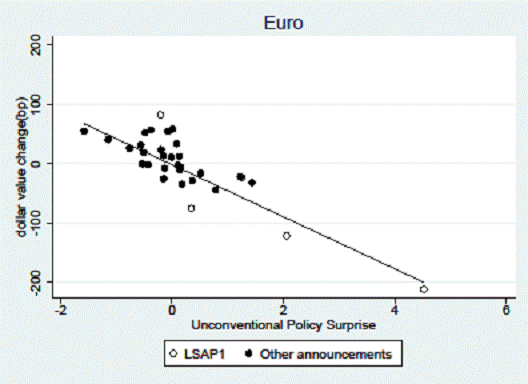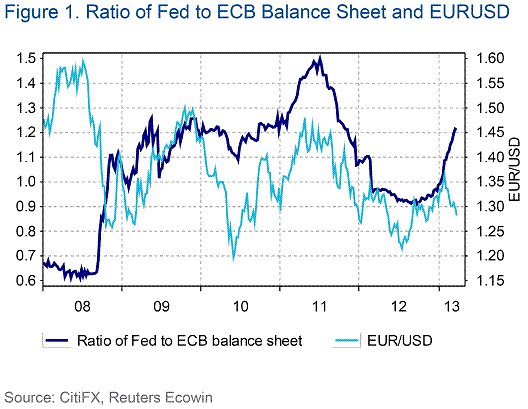The descent of interest rates to near zero in the advanced economies has prompted something of a rethink of how monetary policy can affect exchange rates.
Empirics
I think that there is now accumulating evidence that quantitative easing/credit easing moves by central banks can have an impact on exchange rates, even if short term rates do not move. That point has been most recently documented in an important paper by Reuven Glick and Sylvain Leduc, entitled: “The Effects of Unconventional and Conventional U.S. Monetary Policy on the Dollar”:
We document that the U.S. dollar depreciated significantly following both conventional and unconventional monetary policy surprises. Looking first at the effects of unconventional monetary policy since the end of 2008, we find that a one standard deviation surprise easing in unconventional policy leads to a roughly 40 basis point decline in the value of the dollar within 60 minutes. In turn, we find that in the conventional policy period the dollar depreciated in response to federal funds rate easing surprises, with a one standard deviation surprise easing leading to about a 6 basis point decline in the value of the dollar in the hour after announcements.
…
To enable comparison of unconventional and conventional monetary policy effects, we analyze the comovements in federal funds and long-term rates during the period when the funds rate was above its lower bound. This yields an adjustment parameter that we use to rescale the measure of unconventional policy surprises into equivalent fund rate surprises. The resulting adjusted coefficients indicate that a one standard deviation surprise unconventional policy easing leads to a 5 to 6 basis point depreciation in the dollar, magnitudes that are comparable to those for federal fund rate surprises in the pre-crisis period. This suggests that monetary policy has the same “bang-per-unit-of-surprise” as previously and that the exchange channel of monetary policy is still working as effectively as in the past.
The impact of unconventional policy surprises is shown in the figures below:

Excerpt from Figure 2 of Glick and Leduc (2013). “Scatter Plots of Change in Value of Dollar against Unconventional Policy Surprises, November 2008 – January 2013.” Note: Positive unconventional policy surprises indicate monetary easing and are in standardized units; negative changes in exchange rate indicate depreciation of dollar against the foreign currency in window from 10 minutes before announcement to 20 minutes after.

Excerpt from Figure 2 of Glick and Leduc (2013). “Scatter Plots of Change in Value of Dollar against Unconventional Policy Surprises, November 2008 – January 2013.” Note: Positive unconventional policy surprises indicate monetary easing and are in standardized units; negative changes in exchange rate indicate depreciation of dollar against the foreign currency in window from 10 minutes before announcement to 20 minutes after.
See also Rosa (2012) for another approach to measuring surprises.
Theory
Conventional macroeconomic models of the nominal exchange rate typically rely upon some sort of asset based approach. The monetary approach would say that intercountry differentials in money stocks, incomes and interest and inflation rates matter (and if purchasing power parity held instantaneously, interest and inflation rate differentials would be the same).
Given that quantitative easing (large increases in the money base) have not been manifested in correspondingly large changes in the money supply, it is hard to interpret the exchange rate changes as induced by changes in relative money stocks. In the (Dornbusch-Frankel) sticky price monetary model, if the short term interest rate is bounded at zero, then for constant expected inflation rate, the quantitative easing can’t have an effect.
Three other possibilities present. The first is that quantitative easing drives higher expected future inflation directly; the second is that large scale asset purchases (LSAPs) signal commitment to higher inflation; and the third is a monetary model is not appropriate.
An alternative approach is to interpret the results in a portfolio balance model. FRBSF President John Williams has observed that in order tounderstand LSAP effects:
one has to go back to older, more eclectic theories of asset pricing, such as Tobin’s “portfolio balance” model or Modigliani and Sutch’s “preferred habitat” theory. These assume that a range of heterogeneous investors have different preferences for different asset classes and that arbitrage across these asset classes is limited. This approach has been integrated into a modern, no-arbitrage, asset-pricing framework and has been used to guide empirical analysis of LSAP effects. (See Vayanos and Vila 2009 for a recent theoretical model, and Greenwood and Vayanos 2008 and Hamilton and Wu 2011 for empirical applications.)
In the 2012 revision of his 2010 paper, Neely lays out explicitly a portfolio balance model, within which to interpret the results that have been found thus far.
The Longer Term
The announcement effects relate to high frequency impacts. Do we know the impact over longer term? There, the potential effects are more ambiguous. As Steven Englander observes (“Some balance sheets are more equal than others…”, 4/5/2013) : “Once you allow the possibility that the balance sheet expansion can influence real interest rates, activity and asset markets, the outcome of the balance sheet expansion is ambiguous. It may raise inflation risk and even inflation expectations, but if it simultaneously raises growth, even temporarily, it is not necessarily the case that it is currency negative.”
This ambiguity is highlighted by the lack of tight correlation over time between the ratio of money bases and the respective exchange rate (US, Euro Area and dollar/euro).

Source: Steven Englander, “G10 Focus – Some balance sheet expansions are more equal than others,” CitiFX (4/5/2013) [not online].
Menzie wrote:
I think that there is now accumulating evidence that quantitative easing/credit easing moves by central banks can have an impact on exchange rates, even if short term rates do not move.
Brilliant!! Austrian economists have only known this for 125 years!!
Keep studying. You will learn a lot that has been forgotten/ignored by those seduced by the illusion of 17th Century mercantilism.
Brilliant so now the link between exchange rate manipulation and QE (essentially supply of money) has been made, despite being patently obvious as Menzie writes can we stop thinking QE is to garner internal growth. It is merely used to destroy foreign debt and to try to get some exporting base. Neither of which seems to work as all CB’s speak from the same page. Idiotic anti-growth generating policy.
Ricky
A link please
From 1880’s-90’s
Viva Menger the magnificent !
I don’t think your commenters understand the point of this post.
The effects would seem fairly obvious – when the FED removes dollar-denominated interest bearing assets, it causes lenders to seek such assets abroad. The recent Japanese experience (adoption of QE and dramatic response of the yen) would seem even better evidence than the U.S. experience. And the effects seem to have been well enough understood abroad – witness the complaints of foreign finance ministers about the effects of the U.S. policy.
Interesting paper which outcome is simplifying the multi dimensional variables of the foreign exchange to one and only one variable the monetary policy. Should the scatter plots be stretched to a larger time scale, they would betray the incertitude of the forex markets on a short time scale, selling the USD on a worsening trade balance to be reversed to an appreciation of the USD for the same reason (Fred data: USD foreign exchange vs. balance of trade accounts) The OCC report on derivatives 4 th quarter 2012 p4, does not show more profit from banks but a lesser average foreign exchange profit and loss. Not much volatility in the 6 to 8 bp.